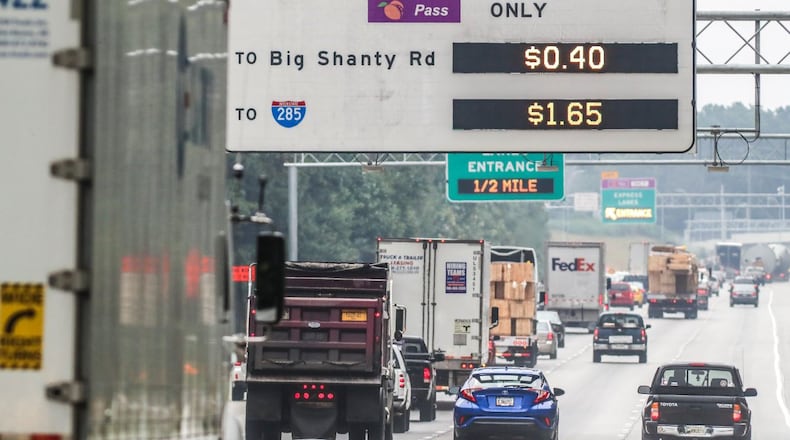Nick DeAngelo was skeptical as he watched the Northwest Corridor Express Lanes rising in Cobb and Cherokee counties.
The Canton resident doubted the toll lanes would make much difference in traffic. And even if they did, he assumed they wouldn’t be affordable. He never planned to use them.
But, when the new lanes opened last month, DeAngelo decided to give them a try for a while. He saved 15 minutes on his morning commute and up to 45 minutes in the afternoon. And it costs him about $3.40 round trip – a price he's willing to pay to get an hour of his life back each day.
“It has been miraculous to say the least,” DeAngelo said.
He’s not the only convert. Motorists took 471,550 trips on the Northwest Corridor during its first month of operation, according to the State Road and Tollway Authority. They’re taking more than 20,000 trips on an average weekday.
That’s a fraction of the nearly 300,000 vehicles that travel I-75 near the Perimeter on an average day. But it’s enough that many commuters say traffic on one of metro Atlanta’s busiest highways has improved, even in the regular lanes.
Not everyone is sold. Some motorists say the lanes have merely moved congestion to points on the highways where the “free” and toll lanes merge. Others say it’s traffic relief only for those who can afford it, but not the average driver.
“The lanes are really not financially realistic for the general population,” said Marietta resident Lisa Schuler-Jones. “I absolutely hate discrimination of any kind, and this falls into that category, in my opinion.”
Like them or not, toll lanes are a big part of the state's plan to address some of the world's worst traffic congestion. And they may be coming soon to a highway near you.
Georgia opened its first metro Atlanta toll lanes on I-85 in DeKalb and Gwinnett counties in 2011. Last year, it opened 12 miles of reversible toll lanes on I-75 in Clayton and Henry counties.
A 10-mile extension of the I-85 lanes will open before the end of the year. Similar lanes are planned along Ga. 400 in Fulton and Forsyth counties and along the top half of the Perimeter.
Altogether, the Georgia Department of Transportation plans 120 miles of toll lanes in metro Atlanta. The new Northwest Corridor is the longest stretch yet developed.
The lanes stretch for 30 miles in Cobb and Cherokee counties – there are two lanes on I-75 from the Perimeter to I-575, and a single lane on both highways north of that junction. The lanes are separated from regular traffic, and they are reversible – carrying traffic into Atlanta in the morning and out of town in the afternoon.
The cost for motorists to use them fluctuates with traffic – the worse the traffic, the higher the toll. The idea is to raise the toll high enough to discourage some people from using the lanes and keep traffic in them moving at 45 mph.
For most of the day, the minimum toll is 10 cents a mile (there's a flat 50-cent-per-trip toll overnight). There is no maximum toll – the highest to date has been $4.95 for the longest possible one-way trip, and average tolls have been much lower.
By comparison, tolls on the 15-mile I-85 lanes, which are more congested, have reached $15.95 for the longest trip.
Chris Tomlinson, executive director of the State Road and Tollway Authority, doesn’t expect tolls on the Northwest Corridor to get that high for a long time. With two express lanes on I-75 (compared to one each way on I-85), there’s plenty of room for more vehicles, and congestion isn’t expected to be a problem.
Maybe that’s why they’re already popular with many commuters.
Vicki Porter commutes from east Cobb to the Cumberland area. She said the Northwest Corridor lanes have cut her commute almost in half.
“I am more than willing to pay what, for me, is a nominal fee for the ease of the drive and the time it saves,” Porter said. “It’s much more relaxing than the stop-and-start traffic on 75.”
Christopher Bennett’s afternoon commute from Midtown to Woodstock used to take up to two hours. Now it’s 45 minutes or less. The cost: $2 to $3 round trip a day.
“I no longer feel like my life is being wasted away sitting in my car, and I have a home life now,” Bennett said.
State data shows traffic often moves much faster in the express lanes than in the regular lanes, especially in the afternoon. On Oct. 5, for example, afternoon traffic averaged 65.4 mph in the express lanes, compared to 36.6 mph in the regular lanes.
Tomlinson declined to predict how quickly traffic in the new toll lanes will increase. But he’s glad they’ve won some early converts.
“The lanes are still new, so we’re in a ramp-up period,” he said. “Things are going well. I like the way they’re trending.”
About the Author
Keep Reading
The Latest
Featured




